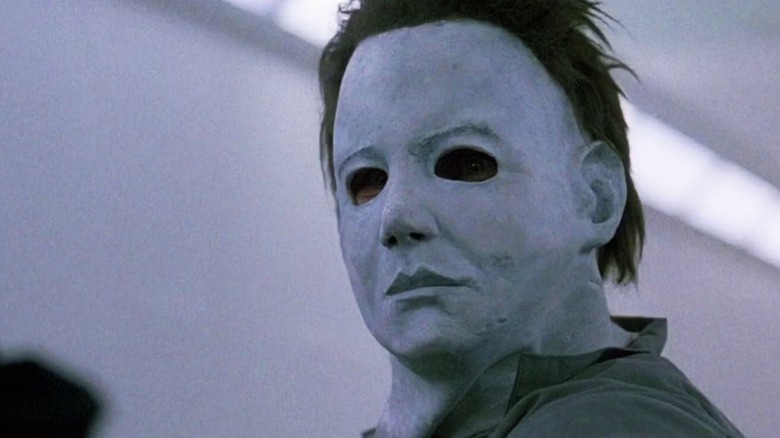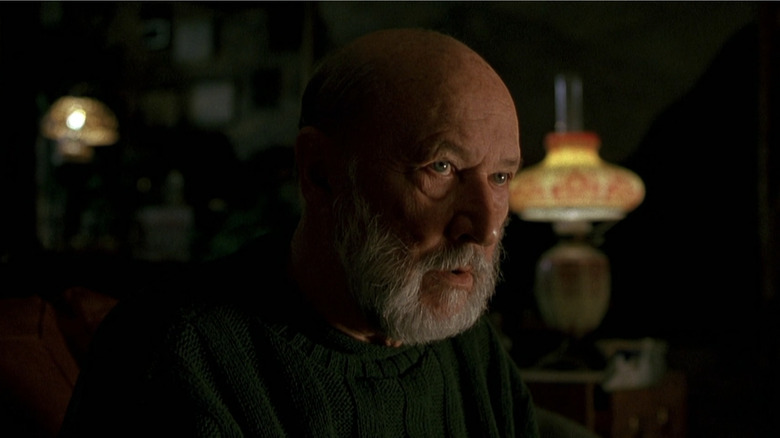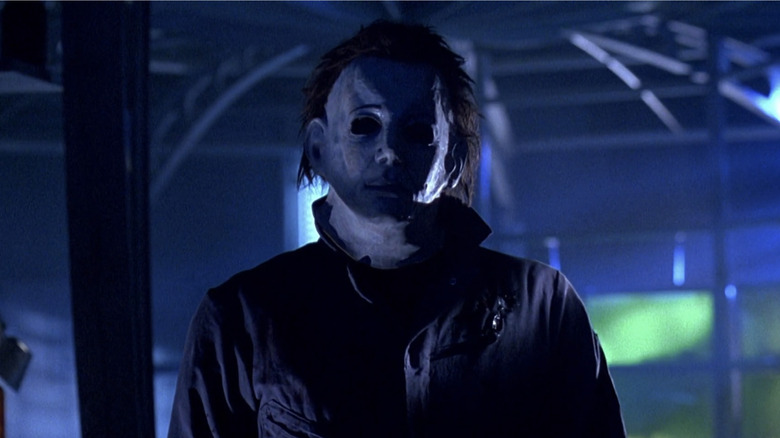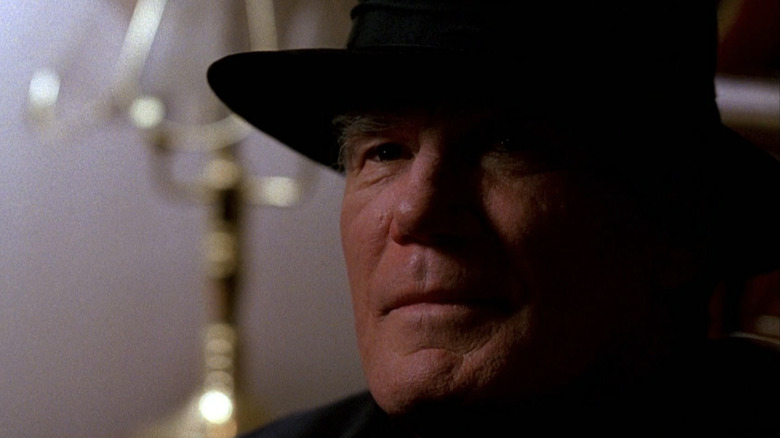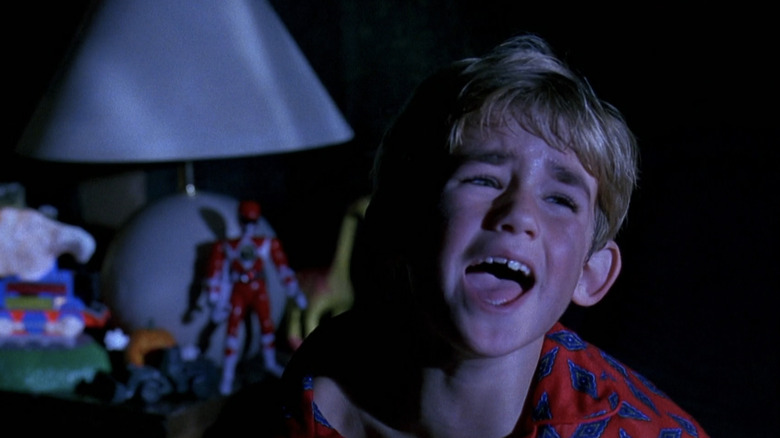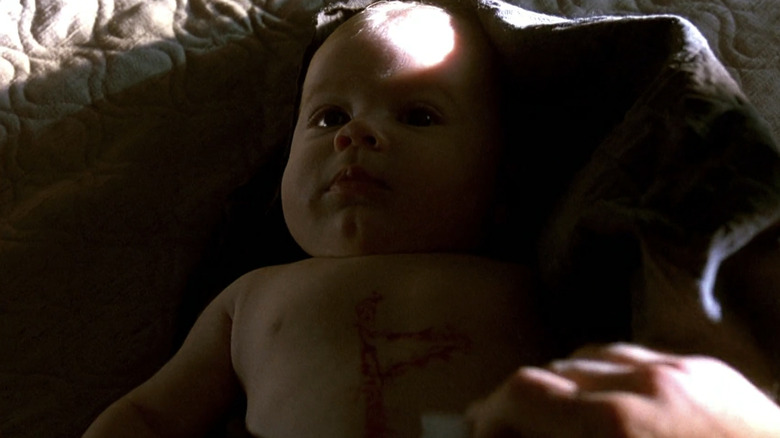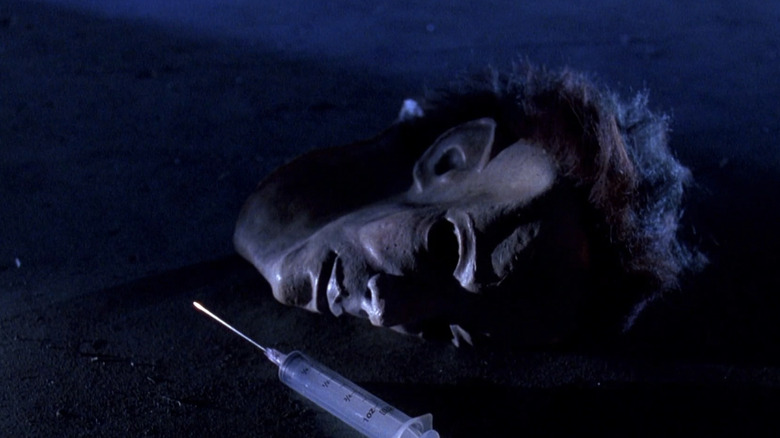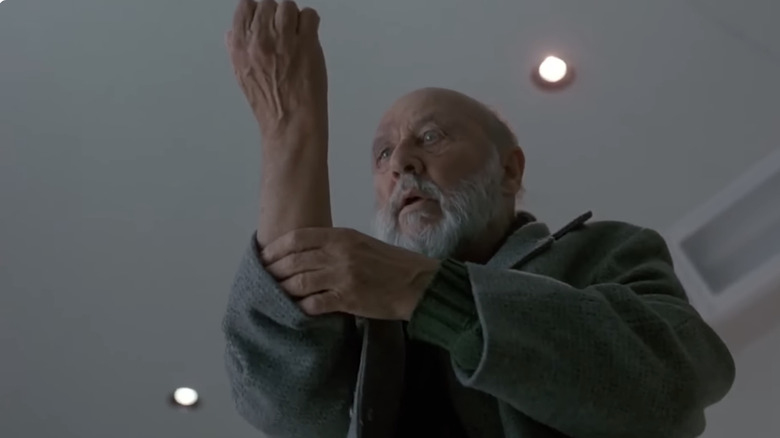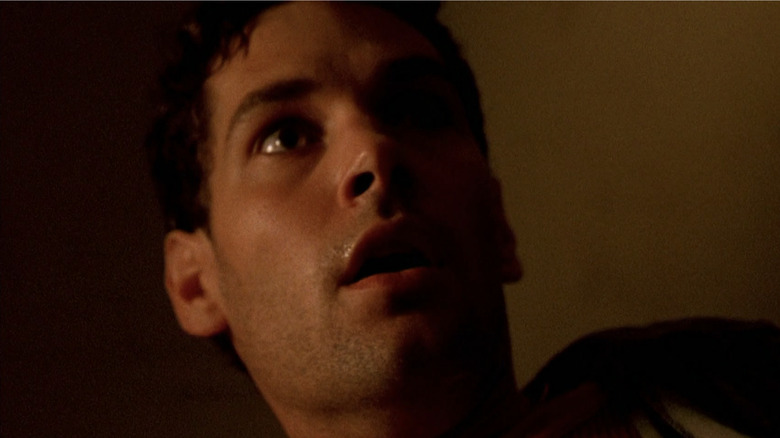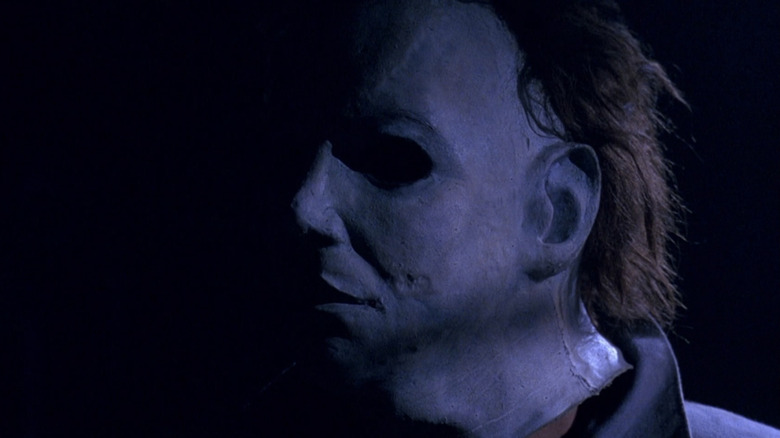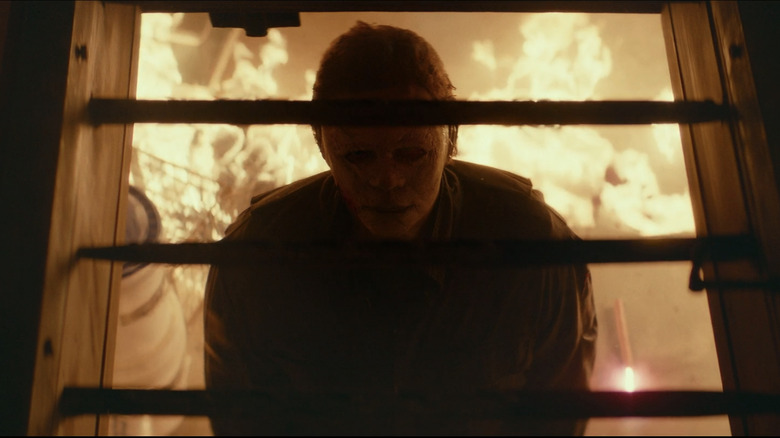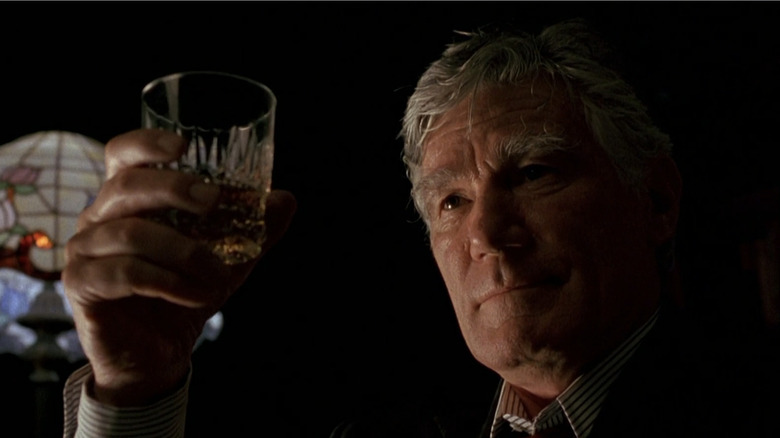The Ending Of Halloween: The Curse Of Michael Myers Explained
After unleashing masked killer Michael Myers on the moviegoing public in 1978's "Halloween" and its 1980 sequel, series creators John Carpenter and Debra Hill tried to expand the franchise beyond the slasher genre they inadvertently helped create. The villain of 1982's "Halloween III: Season of the Witch" is not a knife-wielding maniac but an Irish toy magnate who dreams of returning the spooky holiday to its ancient pagan child-murdering roots. The film was a bit too bleak and off-model for critics and audiences at the time. Six years later, series producer Moustapha Akkad put the ship back on course. "Halloween 4: The Return of Michael Myers,” released in 1988, saw the return of the masked baddie and his nemesis, Dr. Sam Loomis (Donald Pleasence), and introduced a long-lost Myers relation, nine-year-old Jamie Lloyd (Danielle Harris), who shares a psychic link — and perhaps a penchant for murder — with her uncle.
The Jamie Lloyd era of "Halloween" continued with 1989's "The Revenge of Michael Myers" before getting a belated finale with "The Curse of Michael Myers" in 1995. Writer Dan Farrands sought to find a motivation for Michael's evil, and like "Season of the Witch," he turned to the ancient Celtic festival of Samhain, a connection hinted at in "Halloween II" and made explicit in Curtis Richards' 1979 novelization of the original film. However, audiences were not interested in this particular direction for the "Halloween" series, and the film was reshot and recut to be more exciting but much less coherent. Let's look at what remains of the ending of "Halloween: The Curse of Michael Myers."
The plot of Halloween: The Curse of Michael Myers
"The Curse of Michael Myers" picks up six years after the end of "Revenge." Neither Michael nor Jamie have been seen since that film's fiery jailbreak finale and are presumed dead. Dr. Loomis has retired and put the entire Michael Myers saga behind him. Meanwhile, Tommy Doyle (Paul Rudd in his first starring role), last seen as a terrified kid in the first "Halloween," has grown into a spooky weirdo obsessed with Haddonfield's boogeyman. He spends his days and nights in a boarding house, spying on the old Myers house, now the (somewhat unlikely) home of the Strodes, unspecified relatives of original heroine Laurie Strode's adoptive family.
The film begins with a teenage Jamie (now played by J.C. Brandy) giving birth under the care of robed cult members in the basement of the asylum where Michael was confined. One of the cultists paints a rune in blood on the newborn's chest. A sympathetic nurse helps Jamie and her baby escape, but soon, Michael murders the nurse and sets after mother and child. Jamie meets her gruesome end at her uncle's hand, but not before stashing her infant son in a bus station bathroom and using a radio call-in show to warn Haddonfield that Michael has returned. This must be the most popular talk radio show in Northern Illinois because Tommy and Loomis are listening at just the right moment to spring into action against their common enemy.
What happened at the end of Halloween: The Curse of Michael Myers
The druidic cult behind Michael's many rampages is not just after Jamie's baby (whom Tommy discovers in the bus station bathroom and decides to name Steven). They also have their sights on Danny (Devin Gardner), the young son of Kara Strode (Marianne Hagan). After the cult captures Kara, Danny, and Steven, Tommy and Dr. Loomis journey to Smith's Grove Sanitarium to defeat the evil once and for all.
However, Michael, still operating under the celestial mandate to kill every member of his family and anyone who gets in his way, has plans of his own. He hacks, slices, and mutilates his way through the cult members on his way to Steven. The baby is nearly in his clutches when Tommy and Kara get the drop on him, injecting him with syringes filled with an unknown green substance and beating him senseless with a metal pipe. The quartet of survivors escapes into the night, but Loomis stays behind, presumably to ensure that Michael is truly dead this time. Nevertheless, the film's final moments are ambiguous. The last we see of Michael is his mask lying on the ground as Loomis screams out in anguish.
The Man in Black revealed
One of the most puzzling elements of "Halloween 5: The Revenge of Michael Myers" is the presence of a mysterious man clad in black. He acts as Michael's guardian, as when he machine guns the Haddonfield Police Department at the end of the film, allowing Michael to escape his very brief incarceration. The film makes no effort to explain who he is, why he is there, or what exactly he is doing. In "The Curse of Michael Myers," the Man in Black returns, haunting the dreams of young Danny and beckoning him in spooky voiceover. He is the leader of the Cult of Thorn, hunting for new members, just as he had more than 30 years earlier when he compelled six-year-old Michael Myers to murder his sister on Halloween night.
When the cult captures Kara, Danny, and Steven, the Man in Black reveals himself to be Dr. Wynn (Mitchell Ryan), Loomis' old colleague who tries to coax him out of retirement at the start of the film. It's a twist that reaches back to the first film, where the same character was played by Robert Phelan. Wynn's betrayal casts a tragic pall over Loomis' entire character. He spent years trying to cure young Michael of his evil urges, all the while being actively undermined by an old friend in the service of an ancient murder cult.
Wait, is Danny hearing voices?
The film's choppy, abrupt ending leaves several plot points unresolved, mysteries that seemed vitally important to the plot until they suddenly aren't. For example, Danny's connection to the Man in Black provides one of the film's first jump scares. The boy hears his rumbling, demonic voice throughout the movie, and when the nice old lady who runs the boarding house (surprise! also a cult member) reveals that young Michael had also heard the voice before killing his sister in 1963, it seems clear that the cult has targeted Danny to carry on Michael's murder spree.
But by the end, Danny's importance to the Cult of Thorn (and the film) is largely diminished. He's little more than a would-be victim. When Michael nearly kills him, it is only because he is guarding baby Steven. Is there a reason the cult targeted Danny, an innate darkness he and Michael share? Is that something his mother should be concerned with?
Wait, is Steven the ultimate evil baby?
Danny isn't the only child whose importance to the plot wanes in the film's final minutes. Baby Steven is described by Dr. Wynn as the ultimate vessel of evil — "pure, uncorrupted, ancient" — and the result of years of effort by the cult. Those efforts are dramatized when Kara and Tommy wind up in a lab room filled with dead fetuses in glass cases. This grim display is meant to underscore the importance of Steven to the cult's sinister aims but just raises more questions. Is Steven meant to replace Michael as the cult's violent puppet? If so, what's Danny's purpose? If Steven is intended merely to be the absolute last Myers scion for Michael to kill and complete his awful curse, well, why wouldn't the cult accomplish that by having him kill Jamie instead?
There's also the uncomfortable question of Steven's parentage. Jamie is clearly his mother, but who is his father? The film makes absolutely no mention of how Jamie became pregnant, leaving the viewer to speculate whether it was some anonymous donor via in vitro fertilization, Dr. Wynn, another member of the cult, or even, most disturbingly, Michael himself.
Wait, who's killing whom at the end?
The film's final moments are ambiguous to the point of nonsense. Loomis leaves Tommy, Kara, Danny, and Steven behind to attend to "unfinished business." As the quartet of survivors drives away, the movie cuts back to the fetus room where Michael was last seen. The camera tilts to the floor to reveal that Michael's body is gone. Only his mask and an empty syringe remain. Suddenly, Loomis cries out in fear. The film cuts to a shot of the Myers house and a grinning jack-o-lantern on the porch.
The most literal reading is that Loomis returned to the fetus room to find Michael missing. However, Donald Pleasence's scream is filtered to sound echoey and distant, as if Loomis is somewhere else. Did Michael finally get the drop on his old doctor somewhere in the bowels of the hospital where the two first met decades earlier? As we consider that final confrontation, we realize that the film has completely lost track of Dr. Wynn, last seen when Michael slashes his way through an operating room but never confirmed dead.
The Producers Cut and alternate ending
The answers to these questions, for the most part, are found in the film's original ending. After a disastrous test screening, Dimension Films wrested control away from producers and ordered rewrites and reshoots. According to writer Dan Farrands, not only were these hampered by a lack of time and money but also by the tragic fact that Donald Pleasence died before reshoots began. "That's why you see a mask with a needle at the end," he told Icons of Fright in 2005, "because there was no time to shoot a real ending."
The so-called Producers Cut existed in legal limbo, only available in bootleg copies, for years before getting a proper home video release by Scream Factory in 2014 as part of a franchise box set. The differences between the two cuts are considerable — especially their endings. The Producer's Cut ties up those loose ends mentioned above. The cult intends for Michael to kill Steven in a candlelit ritual so Danny can take his place as its main monster. Kara appeals to Michael by implying that he is Steven's father (though how she might know this is never explained). Wynn forcibly passes on his guardianship of Michael to Loomis via a branded Thorn rune on his arm, hence the screaming we hear in the theatrical cut. It is also almost entirely bloodless; No cult members are slaughtered, and Tommy defeats Michael not with a pipe to the head but with runes of his own that freeze the killer in his tracks.
What has the cast and crew said about the ending?
No one was pleased with how "The Curse of Michael Myers" turned out. Even Paul Rudd, for whom this was not only his first lead role but his first film role (his star-making turn in "Clueless" was filmed later but released earlier), disowned the film for a time. "I remember thinking, Oh God, this movie's not good, and I was really bummed out," he told Ain't It Cool News in 2007, adding, "I have since changed my tune; I love it. I'm honored to be part of a franchise that has lasted so long."
While journeyman director Joe Chappelle (who went on to helm episodes of "The Wire" and "Godfather of Harlem") has kept mum over the years, writer Dan Farrands has embraced his role as a "Halloween" scribe. In the decades since, he has been candid about the difficult process of making the film, his support of the Producer's Cut, and alternate ideas for the end that didn't make it into his final script. In an interview with the fan site Halloweenmovies.com in honor of "Curse's" tenth anniversary, Farrands talked through some of his unused ideas, such as having Michael kill Loomis (which was vetoed because Donald Pleasence didn't want to leave the franchise) and having Wynn get blown up by a bomb. "Finally, they went with the 'power of the runes' ending (which I jokingly refer to as 'Tommy's magic acorns')," he said. "Personally, I thought the whole thing was (and looked) rather silly."
Critics were tired of Michael Myers
"The Curse of Michael Myers" was released in September 1995, long after the slasher flick boom of the 1980s had ebbed. Michael's fellow horror icons Jason Vorhees and Freddy Kruger had already packed it in for the decade with "Jason Goes to Hell" in 1992 and "Wes Craven's New Nightmare" in 1995. Neither audiences nor critics seemed all that interested in keeping the genre alive. "It is considerate of the schlockmeisters still toiling in the realm of slasher movies launched in the late '70s to put the name of their immortal bogey men in the titles," L.A. Times critic Jack Matthews joked in his pan. Stephen Holden of the New York Times gently suggested that "it's about time the masks were removed once and for all." Audiences agreed; The film was a bomb, grossing $15 million at the box office.
The Producer's Cut gained a reputation over the years for being a diamond in the rough, at least compared to the hatchet job theatrical version. But when it was finally released widely in 2014, reactions were mixed. Bloody Disgusting ruled that the best version of the film would be a combination of the two cuts. Brian Tallerico of rogerebert.com noted that the producer's cut "really plays like a completely different movie. It's still not a great one."
Evil is reborn... and reborn... and reborn...
However, a funny thing happened a year after "Curse" bombed. "Scream," Wes Craven's self-aware Gen-X slasher, became an unexpected box office hit. Suddenly, these movies were back in fashion — as long as they were sufficiently tongue-in-cheek. In 1998, producers Moustapha Akkad, Bob and Harvey Weinstein, and "Scream" writer Kevin Williamson jumped back into the bloody waters with "Halloween: H20," which marked Jamie Lee Curtis' return to the franchise after nearly two decades and ignored the events of all but the first two films. A 2002 internet-focused sequel followed, notable for killing off Curtis' character (again, after dying offscreen before the events of "Halloween 4") and for starring rapper Busta Rhymes.
In 2007, Rob Zombie, hot off his exploitation throwbacks "House of 1000 Corpses" and "The Devil's Rejects," remade the first "Halloween" in his own grimy image, keeping the franchise scaffolding of Laurie Strode being Michael's sister (first established in "Halloween II" and the 1980 TV edit of the first film) but discarding everything else. In Zombie's version, Michael is driven not by a Celtic curse but by a lifetime of abuse. A sequel followed in 2009, and the franchise lay dormant until director David Gordon Green and writer Danny McBride ("The Righteous Gemstones"), like a couple of pagan druids, raised Michael Myers from the dead to kill again. 2018's "Halloween" ignores all the mythological detritus that had gathered around the character since 1978, casting itself as the only sequel that matters.
Will we ever see the Cult of Thorn again?
David Gordon Green's trilogy, which continued with 2021's "Halloween Kills" and 2022's "Halloween Ends," rewrote some of the characters seen in "The Curse of Michael Myers." Laurie Strode has a daughter, but it isn't the psychic adoptee Jamie Lloyd. She's a straight-laced single mom, played by Judy Greer. While there was talk of getting Paul Rudd to reprise the role of Tommy for "Halloween Kills," the part went to Anthony Michael Hall instead, which is just as well, as the two Tommys have little in common. Although Green's trilogy has easter eggs for fans of the series (and of John Carpenter's work in general), the Cult of Thorn was left out of the fun.
Still, all may not be lost for "Curse" fans. Although "Halloween Ends" ended on a rare definitive note for the series, putting Michael and his murderous disciple in the ground seemingly for good, you can't keep a horror icon (or his intellectual property) down forever. In September 2023, Carpenter teased a possible new chapter for the franchise while promoting his new anthology series "John Carpenter's Suburban Screams," and Miramax Television announced the development of a "Halloween" TV series that will ideally lead into a brand-new extended universe. With hours of television to fill, could the Cult of Thorn rise again? Only second-generation producer Malek Akkad knows for sure.
